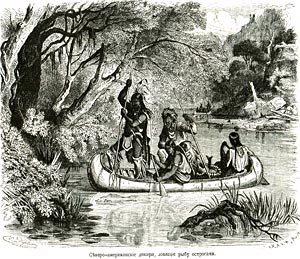Vokrug Sveta

An illustration from the 1861 issue of Vokrug sveta.
|
|
| Categories | Geography |
|---|---|
| Year founded | 1861 |
| Country | Russia |
| Language | Russian |
| Website | http://www.vokrugsveta.ru/ |
Vokrug sveta (Russian: Вокруг света, literally: "Around the World") is a Russian geographic magazine. It is the longest running magazine in the Russian language. The first issue was printed in Saint Petersburg, in December 1861, almost thirty years before the establishment of the National Geographic Magazine. Thus, it is one of the oldest popular science magazines in the world. Release of Vokrug sveta was suspended twice: from 1918 to 1927, during the Russian Revolution, and from 1941 to 1945, during World War II. Nevertheless, the magazine always resumed and continues to be published to this day.
The magazine was conceived by a Warsaw-born entrepreneur, Boleslaw Wolf, who defined Vokrug Sveta as a lavishly illustrated yearly publication, dedicated to "physical geography, natural sciences, the most recent discoveries, inventions and observations". Its roster of authors included: Alfred Brehm, Camille Flammarion, Nikolai Przhevalsky and Nicholai Miklukho-Maklai.
The Wolf edition was discontinued after 1868 for unclear reasons, but the project of a popular geographical journal was revived in 1885 by Ivan Sytin, a printer who directed his periodicals toward a wider audience. Sytin's Vokrug sveta was issued monthly and featured original translations of popular adventure fiction from such authors as Jules Verne, Rudyard Kipling and Arthur Conan Doyle.
The Russian Revolution brought this period of the magazine's history to an abrupt termination. Like many other periodicals of Imperial Russia, Vokrug sveta suspended publication for ten years. It was back in print under the auspices of the Young Communist League, specifically targeted toward the youth audience. Contributing editors included some of the finest Soviet science fiction authors, including Alexander Belayev, Vladimir Obruchev and Ivan Yefremov. In 1938, the magazine's headquarters relocated, from Leningrad to Moscow and its publication was altogether suspended during World War II.
...
Wikipedia
